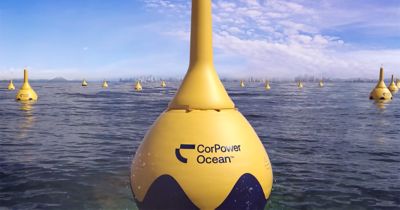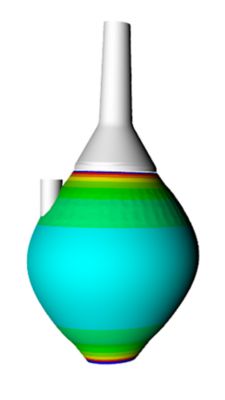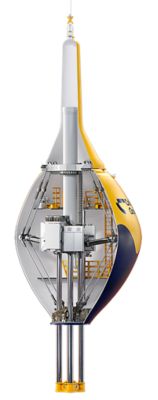-
-
Access Free Student Software
Ansys empowers the next generation of engineers
Students get free access to world-class simulation software.
-
Connect with Ansys Now!
Design your future
Connect with Ansys to explore how simulation can power your next breakthrough.
Countries & Regions
Free Trials
Products & Services
Learn
About
Back
Products & Services
Back
Learn
Ansys empowers the next generation of engineers
Students get free access to world-class simulation software.
Back
About
Design your future
Connect with Ansys to explore how simulation can power your next breakthrough.
Free Trials
ANSYS BLOG
August 30, 2023
Tapping Into the World's Biggest Battery
Think of the ocean as the world’s biggest battery. That’s what CorPower Ocean does. The Swedish firm has developed a wave energy technology that heaves with the movement of the waves. As they do, patented technologies inside the buoys transform the ocean’s wave energy into clean, renewable electricity that can power hundreds of thousands of homes and businesses. And unlike wind or solar energy generation systems, CorPower Ocean’s buoys doesn’t stop generating electricity when the sun sets or the wind settles. The buoys ride the swell of the waves — a more reliable and predictable power source — day and night, helping to balance the grid with clean electricity.

A CorPower Ocean wave energy farm. Image courtesy of CorPower Ocean
Like any technology designed for use at sea, success depends upon the technology’s ability to perform properly under variable and unforgiving conditions. Yet as in any young company with a big idea and a small budget, it’s not possible (or even desirable) to build, haul out to sea, and test prototypes of every single technology or buoy design variant that the company’s engineers might propose. How best to cost-effectively ensure that designs will survive and perform reliably in these conditions? CorPower Ocean’s engineer’s rely on simulation tools from Ansys.
Simulating Surges by the Sea
With an easily exploitable global potential of 500 GW, a figure comparable to today’s cumulative hydro capacity — and even surpassing the todays’ nuclear capacity — wave energy stands out as one of the world's largest untapped source of clean energy. CorPower Ocean’s wave energy converters are designed to be tethered to the sea floor, and a CorPack cluster of buoys can produce 10 MW–20 MW of electrical energy. Multiple CorPack clusters can be linked — all sharing a common electrical transmission infrastructure — to deliver gigawatts of electricity.

The buoy is tethered to the seafloor via a patented anchoring technology. A cable links multiple buoys and passes clean electrical energy into the local grid. Image courtesy of CorPower Ocean
At the same time, much of the body of each 19-meter buoy sits like an iceberg beneath the surface of the ocean. Even from a nearby coast, you can hardly see the slender tops of the tear-shaped buoys. This makes the CorPower Ocean wave system much more attractive to coastal communities. These communities might not like big wind turbines blocking their view of the ocean from high above the water. Indeed, a wave farm of CorPower Ocean’s buoys configured to produce the same electrical output as a oceanic wind farm takes up only a third of the surface area required by such a wind farm and is virtually invisible from the shore.
But some of those seacoasts are not very friendly to any man-made object. The saline environment is corrosive, and storm surges can transform a sea that is relatively gentle one day to one buffeted by waves that can be tens of meters tall the next. Other wave generation technologies have failed because of the variability encountered in these extreme conditions, and the challenge of designing a system that is extremely effective in extracting power from the ocean, while surviving the extremes of 100-year storms, is why CorPower Ocean knew it needed to address these issues from the beginning.
“We use MetOcean data from the most energetic sites,” says Ho-Ann Chen, a Composite Design Engineer at CorPower Ocean, “including wave height, period and direction, as well as tides, currents, and more. These variables become inputs for proprietary ‘wave-to-wire’ model that CorPower Ocean uses to model expected design loads and energy outcomes from individual locations.”
Those inputs also help Chen and other engineers at CorPower Ocean test and refine the design of the buoys and the energy-generating technologies they house.
“We needed to design structures that are optimized for energy production, cost, and survival of extreme storms” says Javier Verdeguer, the Lead Composite Engineer at CorPower Ocean. For these tasks, Ansys Mechanical and Ansys Fluent provided powerful simulation support. The engineering teams used Mechanical and Fluent to model, test, and refine the physical size and shape of the buoys.
“We used simulation throughout the design phase,” Verdeguer continues. “We ran all kinds of simulations involving storms of differing strengths and wave-slamming events against the hulls of a buoy. We looked at simulations where giant waves washed over the buoys and left them submerged at different depths for a period of time. Did they buckle? Where were there structural weaknesses? We looked at different designs to see how they performed under a wide range of simulated stress loads, evaluated them for fatigue performance, and then used the results of those simulations to optimize the geometry of the buoys with those loads in mind.”
CorPower Ocean’s designers even used Ansys Composite PrepPost simulations to determine the optimal combination of filament materials and winding patterns that would be used to wrap the composite materials of which the buoy hulls are constructed. Using a design of experiments approach, they ran optimization studies to determine which combination of filaments, wound at different angles, would produce the lightest yet strongest hulls. They then passed these optimization specifications to the software controlling the filament winding systems in CorPower Ocean’s mobile factory system, which enables CorPower Ocean to construct the composite hulls at the location where the buoys are to be deployed. That has eliminated the need to transport the buoys from what would normally be a distant manufacturing facility to the location where they are to be installed.

Simulation mesh structure of a composite joint in a CorPower Ocean buoy. Image courtesy of CorPower Ocean
Wave Goodbye to Large-scale Prototyping
While CorPower Ocean has built and operated at sea a half-scale device, and is progressing with its full-scale proof-of-concept deployment in Agucadoura, Portugal, the company has been able to rely on simulation to avoid the need to build and test prototypes every time a design refinement is proposed. Early physical tests involving a few key prototypes effectively validated the outcomes projected in simulation. This enabled the engineering teams to feel confident that the outcomes indicated by simulation were predictive of what would actually occur in the real world. The effect has been to accelerate design — for CorPower Ocean engineers do not need to wait for prototypes to be built, delivered, towed out to sea, and tested; they can see the results in simulation within minutes or hours — as well as to reduce the cost of design. This both accelerates delivery of optimized, customer-ready products and ensures that CorPower Ocean can offer those products at a price that customers can cost-justify, even when planning very large-scale deployments.

ACP composite modeling winding pattern mapping. Here CorPower Ocean can accurately define the ply definition of its winded products.

As the buoy rises and falls on ocean waves, technology within the buoy converts wave energy into rotational energy that generates electricity. Image courtesy of CorPower Ocean
“We’re ultimately building large, complex generation systems,” says Verdeguer. “The more you can catch problems and optimize outcomes in the design phase, the more effectively you can de-risk a project.”
As the world races to embrace clean, renewable energy sources — particularly ones that can reliably produce green energy on a 24/7 basis — speeding up design while simultaneously de-risking the project is definitely a good thing.